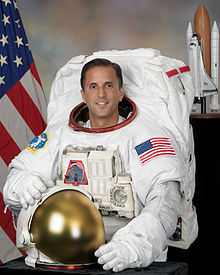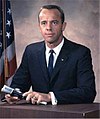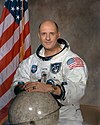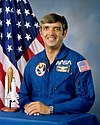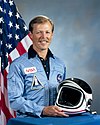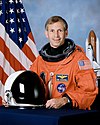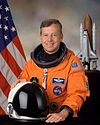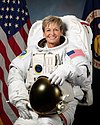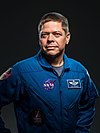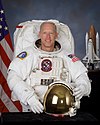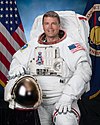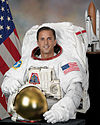History
When Deke Slayton was grounded from the Mercury Seven due to a heart condition, he took on the position of Coordinator of Astronaut Activities and informally held the title of "chief astronaut". In this role, he held responsibility for the operation of the astronaut office. [2]
The position of Chief of the Astronaut Office was officially created in July 1964, when Alan Shepard was named as the first Chief Astronaut. His responsibilities included monitoring the coordination, scheduling, and control of all activities involving NASA astronauts. This included monitoring the development and implementation of training programs to assure the flight readiness of pilot and non-pilot personnel for space flights; furnishing pilot evaluations applicable to the design, construction, and operations of spacecraft systems and related equipment; and providing scientific and engineering observations to facilitate mission planning, formulation of operational procedures, and selection and conduct of experiments for each flight. [3]
The Chief of the Astronaut Office often returns to active duty once their term is complete.

Alan Bartlett Shepard Jr. was an American astronaut. In 1961, he became the second person and the first American to travel into space and, in 1971, he became the fifth and oldest person to walk on the Moon, at age 47.

Donald Kent "Deke" Slayton was an American Air Force pilot, aeronautical engineer, and test pilot who was selected as one of the original NASA Mercury Seven astronauts. He went on to become NASA's first Chief of the Astronaut Office and Director of Flight Crew Operations, responsible for NASA crew assignments.

Leroy Gordon "Gordo" Cooper Jr. was an American aerospace engineer, test pilot, United States Air Force pilot, and the youngest of the seven original astronauts in Project Mercury, the first human space program of the United States. Cooper learned to fly as a child, and after service in the United States Marine Corps during World War II, he was commissioned into the United States Air Force in 1949. After service as a fighter pilot, he qualified as a test pilot in 1956, and was selected as an astronaut in 1959.

Ronald Ellwin Evans Jr. was an American electrical engineer, aeronautical engineer, officer and aviator in the United States Navy, and NASA astronaut. As Command Module Pilot on Apollo 17 he was one of the 24 astronauts to fly to the Moon, and one of 12 people to fly to the Moon without landing.
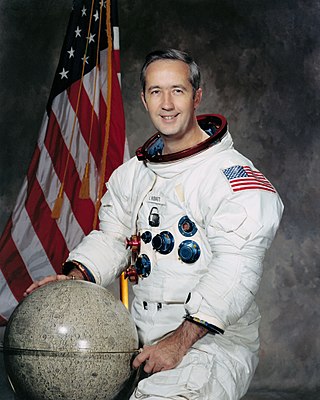
James Alton McDivitt Jr. was an American test pilot, United States Air Force (USAF) pilot, aeronautical engineer, and NASA astronaut in the Gemini and Apollo programs. He joined the USAF in 1951 and flew 145 combat missions in the Korean War. In 1959, after graduating first in his class with a Bachelor of Science degree in Aeronautical Engineering from the University of Michigan through the U.S. Air Force Institute of Technology (AFIT) program, he qualified as a test pilot at the Air Force Experimental Flight Test Pilot School and Aerospace Research Pilot School, and joined the Manned Spacecraft Operations Branch. By September 1962, McDivitt had logged over 2,500 flight hours, of which more than 2,000 hours were in jet aircraft. This included flying as a chase pilot for Robert M. White's North American X-15 flight on July 17, 1962, in which White reached an altitude of 59.5 miles (95.8 km) and became the first X-15 pilot to be awarded Astronaut Wings.

Alfred Merrill Worden was an American test pilot, engineer and NASA astronaut who was command module pilot for the Apollo 15 lunar mission in 1971. One of 24 people to have flown to the Moon, he orbited it 74 times in the command module (CM) Endeavour.

The Mercury Seven were the group of seven astronauts selected to fly spacecraft for Project Mercury. They are also referred to as the Original Seven and Astronaut Group 1. Their names were publicly announced by NASA on April 9, 1959; these seven original American astronauts were Scott Carpenter, Gordon Cooper, John Glenn, Gus Grissom, Wally Schirra, Alan Shepard, and Deke Slayton. The Mercury Seven created a new profession in the United States, and established the image of the American astronaut for decades to come.

The United States Astronaut Badge is a badge of the United States, awarded to military and civilian personnel who have completed training and performed a successful spaceflight. A variation of the astronaut badge is also issued to civilians who are employed with the National Aeronautics and Space Administration as specialists on spaceflight missions. It is the least-awarded qualification badge of the United States military.

The Bell Aerosystems Lunar Landing Research Vehicle was a Project Apollo era program to build a simulator for the Moon landings. The LLRVs were used by the FRC, now known as the NASA Armstrong Flight Research Center, at Edwards Air Force Base, California, to study and analyze piloting techniques needed to fly and land the Apollo Lunar Module in the Moon's low gravity environment.

Charles Arthur "Charlie" Bassett II, , was an American electrical engineer and United States Air Force test pilot. He went to Ohio State University for two years and later graduated from Texas Tech University with a Bachelor of Science degree in Electrical Engineering. He joined the Air Force as a pilot and graduated from both the Air Force's Experimental Test Pilot School and the Aerospace Research Pilot School. Bassett was married and had two children.

NASA Astronaut Group 3—'The Fourteen'—was a group of fourteen astronauts selected by NASA for the Gemini and Apollo program. Their selection was announced in October 1963. Seven were from the United States Air Force, four from the United States Navy, one was from the United States Marine Corps and two were civilians. Four died in training accidents before they could fly in space. All of the surviving ten flew Apollo missions; five also flew Gemini missions. Buzz Aldrin, Alan Bean, Gene Cernan and David Scott walked on the Moon.

NASA Astronaut Group 5 was a group of nineteen astronauts selected by NASA in April 1966. Of the six Lunar Module Pilots that walked on the Moon, three came from Group 5. The group as a whole is roughly split between the half who flew to the Moon, and the half who flew Skylab and Space Shuttle, providing the core of Shuttle commanders early in that program. This group is also distinctive in being the only time when NASA hired a person into the astronaut corps who had already earned astronaut wings, X-15 pilot Joe Engle. John Young labeled the group the Original Nineteen in parody of the original Mercury Seven astronauts.

NASA Astronaut Group 6 was a group of eleven astronauts announced by NASA on August 11, 1967, the second group of scientist-astronauts. Although Director of Flight Crew Operations Deke Slayton planned to hire 20 to 30 new scientist-astronauts, he did not expect any to fly because of a surplus of astronauts amid the looming dearth of post-Apollo program funding, exemplified by the concomitant devolution of the Apollo Applications Program into the Skylab Program. NASA found that only 11 of the 923 applicants were qualified, and hired all.
Astronauts hold a variety of ranks and positions. Each of these roles carries responsibilities that are essential to the operation of a spacecraft. A spacecraft's cockpit, filled with sophisticated equipment, requires skills differing from those used to manage the scientific equipment on board, and so on.

NASA Astronaut Group 7 was a group of seven astronauts accepted by the National Aeronautics and Space Administration (NASA) on August 14, 1969. It was the last group to be selected during the Project Apollo era, and the first since the Mercury Seven in which all members were active-duty military personnel, and all made flights into space.

NASA Astronaut Group 19 was a NASA spaceflight team that saw the training of two pilots, six mission specialists, three educator mission specialists to become NASA astronauts. These 11 astronauts began training in 2004. This was the last group to fly the Space Shuttle.

Gregory Reid Wiseman is an American astronaut, engineer, and naval aviator. He served as Chief of the Astronaut Office until November 14, 2022.
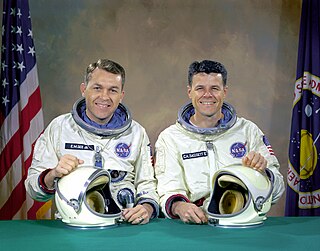
The 1966 NASA T-38 crash occurred when a NASA Northrop T-38 Talon crashed at Lambert Field in St. Louis, Missouri, on February 28, 1966, killing two Project Gemini astronauts, Elliot See and Charles Bassett. The aircraft, piloted by See, crashed into the McDonnell Aircraft building where their Gemini 9 spacecraft was being assembled. The weather was poor with rain, snow, fog, and low clouds. A NASA panel, headed by the Chief of the Astronaut Office, Alan Shepard, investigated the crash. While the panel considered possible medical issues or aircraft maintenance problems, in addition to the weather and air traffic control factors, the end verdict was that the crash was caused by pilot error.

